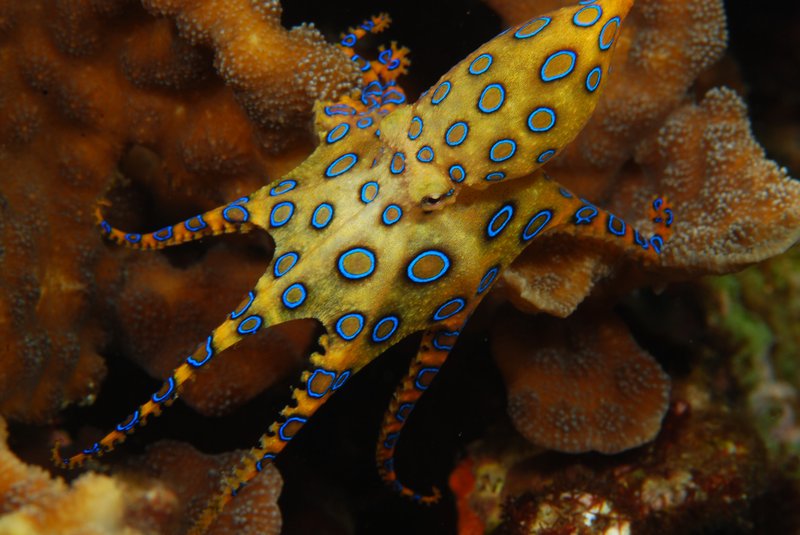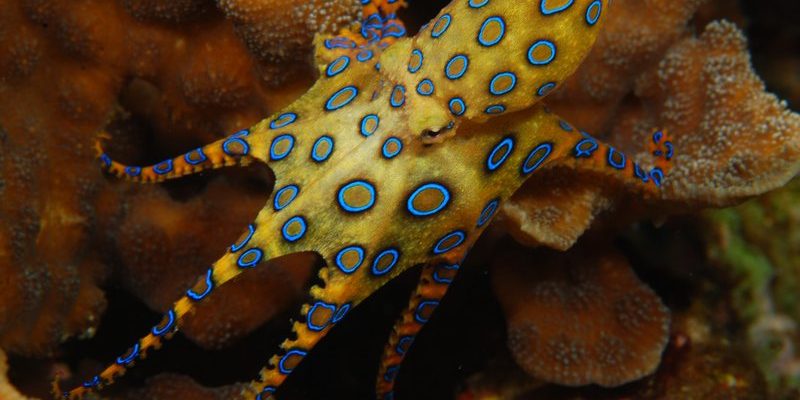
These octopuses are small but mighty, typically measuring just a few inches across. Their unique appearance and potent venom make them fascinating subjects for scientists and nature lovers alike. So, let’s dive deeper into some amazing facts about the blue-ringed octopus that not only showcase its biological wonders but are sure to intrigue you.
1. The Colorful Warning System
One of the first things you’ll notice about the blue-ringed octopus is its dazzling blue rings. But they aren’t just for show. When the octopus feels threatened or agitated, these rings light up in brilliant hues, acting as a warning to predators. Think of it like a neon sign that says, “Stay away!” This color change comes from specialized cells called chromatophores in their skin, which expand and contract to alter their coloration.
Interestingly, in a calm state, these rings can be barely visible, blending into the reef or ocean floor. But when alarmed, it’s like flipping a switch—those bright blue rings start flashing, and anyone nearby knows it’s time to back off.
2. Tiny But Deadly
Despite being small—usually about the size of a golf ball—the blue-ringed octopus packs a serious punch. Its venom contains tetrodotoxin, a substance that can be lethal to humans. Just a tiny amount can cause paralysis and even death. To put it in perspective, this toxin is about 1,200 times more toxic than cyanide!
You might wonder how such a small creature can produce such a powerful toxin. Essentially, it’s a defense mechanism. The octopus has no means of escape, so it relies on its venom to deter predators. Fortunately, humans are rarely affected unless they handle or provoke the creature. So, if you encounter one, the best advice is always to admire it from a safe distance.
3. Unique Hunting Strategies
Blue-ringed octopuses are expert hunters. They primarily feed on small crustaceans, such as crabs and shrimp. But here’s the kicker: they don’t just grab their prey; they use a clever technique to catch it. When hunting, they sneak up quietly and then strike with lightning speed.
Once they’ve caught their meal, they inject it with venom using their beak, similar to how a parrot might eat seeds. This venom not only immobilizes the prey but also helps the octopus to eat it more easily. Imagine having the ability to paralyze your food before eating; it’s a game-changer in the animal kingdom!
4. Short Lifespan, Big Impact
Life as a blue-ringed octopus is short and sweet. Most of these creatures only live for about two years. While that might seem brief, it doesn’t stop them from making a significant ecological impact in their habitats. They have a vital role in controlling the populations of their prey and maintaining the balance of marine ecosystems.
Their relatively fast life cycle allows them to reproduce quickly, ensuring that there are always new generations emerging. However, this short lifespan also means they need to make the most of their time in the ocean. They grow quickly and often reach maturity within just a few months, ready to continue their legacy.
5. Camouflage Masters
Blue-ringed octopuses are not only about bright colors; they are also incredible at blending in with their surroundings. They can change their skin texture and color to match the ocean floor, which serves as an effective strategy against predators. It’s like having a built-in invisibility cloak!
Their ability to camouflage helps them hunt and hide from dangers, allowing them to thrive in various environments, from coral reefs to tide pools. Think about it—being able to turn into your surroundings at will! It’s a fascinating adaptation that gives them a fighting chance in a world full of larger, hungry creatures.
6. Remarkable Intelligence
Octopuses in general are known for their intelligence, and the blue-ringed variety is no exception. They exhibit complex behaviors and problem-solving skills that often surprise marine biologists. For instance, they can open jars to retrieve food, and they engage in playful activities, like playing with objects in their environment.
This intelligence gives them an edge when it comes to hunting and avoiding predators. They can learn from experience, adapting their strategies as needed. You might even say that in the animal kingdom, they’re the clever ones—knowing how to navigate their world with finesse and skill.
7. Reproduction: A Tragic Cycle
When it comes to reproduction, blue-ringed octopuses have one of the most poignant life stories. Female blue-ringed octopuses lay hundreds of eggs, carefully guarding them until they hatch. During this time, she doesn’t eat and eventually dies after the eggs hatch.
This intense commitment to their offspring highlights the incredible cycle of life in the ocean. While it’s tragic for the female, it ensures that the next generation has the best chance of survival. The newly hatched octopuses are on their own right from the start, immediately diving into the challenges of ocean life.
8. Geographic Distribution and Habitats
You might be surprised to learn that blue-ringed octopuses are found in various locations across the Indo-Pacific region, particularly around Australia and Japan. They tend to dwell in shallow waters, hiding among coral reefs and rocky crevices. Their habitat preferences are primarily linked to their hunting strategies and camouflage methods.
This geographic distribution plays a crucial role in how they interact with their ecosystems. They can be found in tide pools or the shallow sea beds, where they can easily ambush unsuspecting prey. Each location offers a unique environment that fosters their survival tactics, contributing to their success as a species.
9. The Blue-Ringed Octopus in Culture
Interestingly, the blue-ringed octopus has made its mark not just in science but also in popular culture. They often appear in documentaries, aquarium exhibits, and even video games. Their striking look and intriguing behaviors capture the imagination, making them a favorite among marine enthusiasts.
Many people find them fascinating, not just because they are beautiful but also because of their deadly nature. This duality makes the blue-ringed octopus a symbol of nature’s delicate balance—attractive yet perilous. It serves as a reminder of how much wonder the ocean holds, inviting us to explore and respect its inhabitants.
10. Conservation Status and Future
Finally, the future of the blue-ringed octopus is tied to the health of our oceans. While they are not currently endangered, habitat destruction and pollution present ongoing challenges. Coral reefs are under threat from climate change, and with them, the delicate balance of marine life can be disrupted.
Conservation efforts focused on protecting marine ecosystems can help ensure that blue-ringed octopuses continue to thrive in their natural habitats. After all, every creature plays a role in the ocean’s intricate tapestry, and preserving these environments is crucial for the survival of countless species, including our fascinating friend, the blue-ringed octopus.
In conclusion, the blue-ringed octopus is a remarkable creature that combines beauty, intelligence, and danger in one small package. Whether you admire them from afar or are lucky enough to see one in the wild, remembering these facts can deepen your appreciation for the wonders of marine life. So next time you hear someone mention the blue-ringed octopus, you’ll know just how fascinating—and vital—these tiny cephalopods truly are!

